Space time block code is a transmit diversity strategy used in MIMO technology. STBC-OD design is an attractive code which is having the property of full code rate and full diversity and single symbol decoding for two transmit antennas. Whereas this codes fails for the rate-1 transmission of more than two transmit antennas with the complex signal constellations. To achieve a full code rate and full diversity Space-time block code from coordinate interleaved orthogonal design (STBC-CIOD) is used in this paper.
Keywords |
| Space-time coding, multiple-antenna systems, STBC-CIOD design. |
INTRODUCTION |
| Over a past decades wireless communication is an important one which supports a wide range of applications like voice
and video, email, web browsing. These are the some of the application and essential part of our daily life. But there is a
demand for providing such a reliable communication due to effects of some wireless impairment like shadowing and
multipath effects. Due to this effect in radio communication information carrying electromagnetic signal met with
surrounding environments such as obstacles, buildings, hills. Thus the wave fronts are scattered and they take many
paths to reach the destination is called multipath effects. The later arrival of scattered portions of the signal causes the
problems such as fading and it will also increases some errors. Also this wireless communication is shared by many
users and applications which create the problems called interference. These are major problem of wireless
communication. Because of these problem we cannot able to utilize the available bandwidth efficiently and the transmit
power, hardware complexity, cost also gets increased. MIMO technology takes advantages of multipath effect. The
technology offers a number of benefits that help meet the challenges posed by both the impairments in the wireless
channel as well as resource constraints. In addition to the diversity technique are exploited in MIMO are realized by
exploiting the spatial diversity (provided by the multiple antennas at the transmitter and the receiver). The widely used
diversity technique is time, frequency diversity. This sort of diversity technique is used to improve the performance of
wireless communication over a fading channel. Spatial diversity is an effective approach to increase the rate of wireless
communication without increasing the additional bandwidth and power. This paper is organized as follows. Space time
block codes is presented in section II, system model and Design of STBC-CIOD code designs are provided in section
III, performance analysis in section IV, Conclusions in section V. |
SPACE TIME BLOCK CODES |
| Space time block coding is a transmit strategy in MIMO technology this technology takes the advantage of time and
frequency diversity. Space time block codes are usually represented by a channel matrix. |
| Let us Assume N be the no of transmit antennas and M be the no of receiving antennas, T is a time slot and for a each
time slot T signal points Sit (i=0,1,2……N-1) are transmitted from the N transmit antennas simultaneously, hij=αijejθij is
the path gain from ith transmit antenna to the jth receive antenna. And also assume that this path gains are constant over
L≥N, t=0,….L-1, ϑij is the received signal at a jth antenna over a T time slots . |
| Received signal is denoted by. |
| ϑij= = Σn-1i=0 hij Sit + njt
where j=0,….M-1; t=0,…….L-1 |
| In matrix representation |
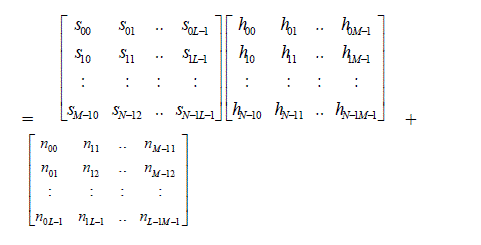 |
| Received signal vector can be calculated as |
| V=SH+N |
| Space time block codes from orthogonal design (COD) which is also known as Alamouti code is a attracting one due to
their full code rate and single symbol ML decoding for a complex constellations. The drawback of this code is for more
than two transmit antennas it sacrifice these advantages that is for more no of antennas this Alamouti code provides the
full diversity with a less code rate. Space time block codes from QOD provides the full code rate, full diversity for
more no of antennas but this code attracts a double decoding complexity. Whereas the another code has been
significant interest in providing a full code for more than two transmit antennas, which is called space time block code
from coordinate interleaved orthogonal (STBC-CIOD) codes, since this code posses a advantage of providing full
diversity and full code rate(rate-1) with a single symbol decoding for any complex constellations. |
SYSTEM MODEL |
| From fig 1: The information symbols are encoded using STBC-CIOD codes after the encoding the symbols are given to
the mapping section and the mapped symbols are transmitted parallel using no of antennas. We assume that no of
transmit and receive antenna at source and the destination is four. Channel coefficients among the source and
destination is assumed to be Rayleigh fading with mutually independent and additive white Gaussian noise(AWGN)
having zero mean and variance N(0,σ2) and also assume that the perfect channel state information is available only at
the receiver to decode the original transmit signal. |
COORDINATE INTERLEAVED ORTHOGONAL DESIGN |
| This code provides a full diversity full code rate for more no of antennas. In this scheme we are interleaving the inphase
and quadrature components of the variables of a design in order to face the different levels of fading and wireless
impairments. |
| From the fig 2: information symbols are given to the mapping (16QAM) section and the mapped symbols are rotated
by angle θ (θ=31.7175°) |
COORDINATE INTERLEAVED DESIGN FOR FOUR ANTENNAS |
| Let xi be the complex indeterminate, where xi=xiI+jxiQ, ( i=0,1,2,3,4), xiI and jxiQ are the real and imaginary part of xi.
The coordinate interleaved design of xi will be Xi~=xiI+jx(i+K/2)K Q, coordinate interleaved version for four complex in
determinates are |
| x0
~ =x0,I+jx2,Q |
| x1
~ =x1,I+jx3,Q |
| x2
~ =x2,I+jx0,Q |
| x3
~ =x3,I+jx1,Q |
| The transmitted symbols using STBC-CIOD at the source is given by |
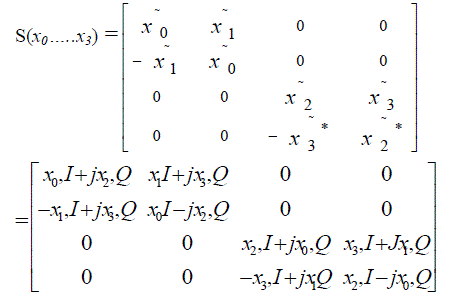 |
| To achieve a full diversity and full code rate the symbols are rotated by θ=31.7175° [1], from the above matrix in first
time interval the first two antenna will transmit a information and another two antenna will transmit nothing, in second
time period first two antenna will transmit nothing and another two antenna will transmit a information.
The received signal will be |
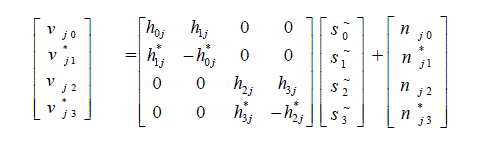 |
| Vjt is a received signal at a time slot t where t=0,1,2,3,4 and hijis a path gain, Si is a transmitted symbols and this Si is
replaced by xi, n is a AWGN noise. Comparison of CIOD, COD and QOD codes is shown in table 1: from this table
CIOD is the only code which provides the advantage of full code rate and full diversity with a single symbol decoding
for more than two transmit antennas. Also table 2: code rate of ciod codes, which provides the better code rate than
another codes. |
| SOURCE: D˜ung Ngo & Ðào,C & Chintha Tellambura, 2008, ‘Decoding, Performance Analysis, and Optimal Signal
Designs for Coordinate Interleaved orthogonal designs, IEEE, vol.7,no.1,januray. |
| SOURCE: D˜ung Ngo & Ðào,C & Chintha Tellambura, 2009, ‘On Space-Time Block Codes from Coordinate
Interleaved Orthogonal Designs, IEEE,vol.7,no.1,December 21. |
CONCLUSION |
| In this paper 4x4 antenna with the STBC-CIOD code is analyzed. The fig 3 shows the performance analysis of 4
transmit antenna using 1 receive antenna with CIOD design, for a 16QAM this code design achieves the above 25db
snr for 0.1 symbol error. Fig 4 shows the performance of CIOD codes for 6 Tx antennas using 1 Rx antenna achieves
the 35 db snr for a 0.1 symbol error. From fig 5 for 4x4 antennas using CIOD code design we may achieve the 30 db
snr for a 0.1 symbol error. Thus by using the CIOD codes we may achieve better code rate and full diversity . |
| |
Tables at a glance |
 |
 |
| Table 1 |
Table 2 |
|
| |
Figures at a glance |
 |
 |
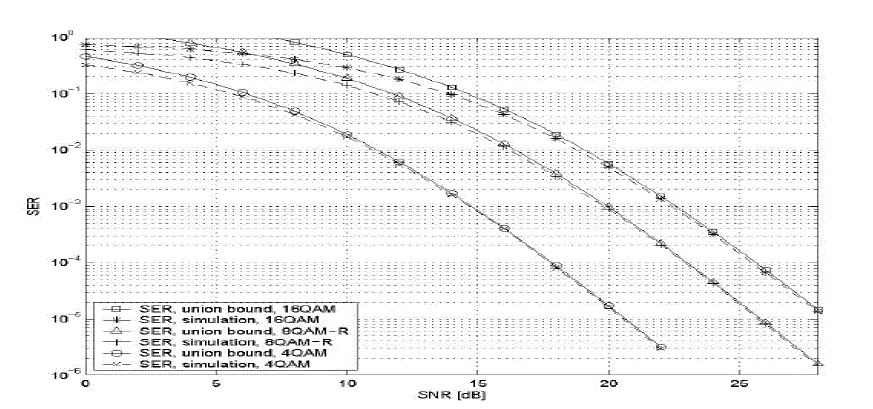 |
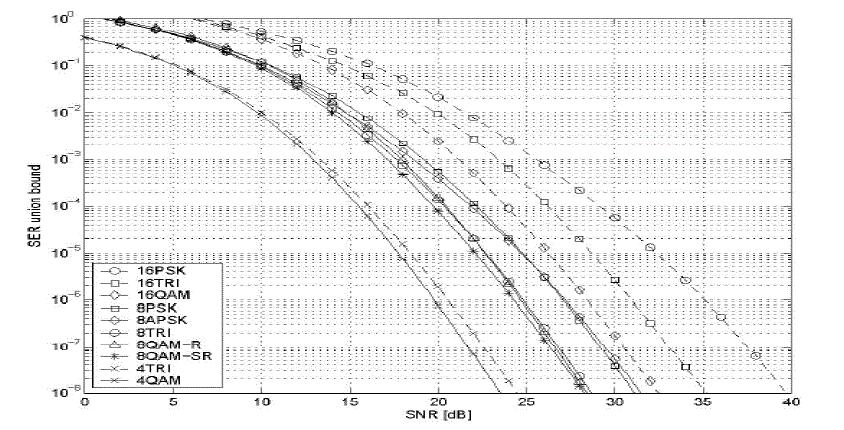 |
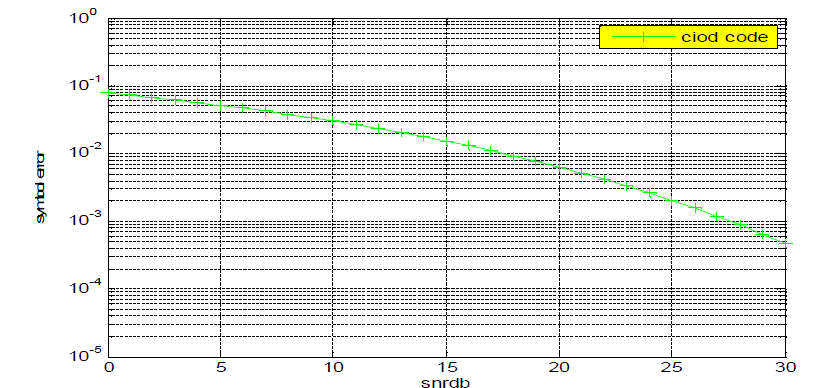 |
| Figure 1 |
Figure 2 |
Figure 3 |
Figure 4 |
Figure 5 |
|
| |
References |
- Tarokh, V & Jaferkhani,H & Calderbank ,AH, 1999, ‘Space time block codes from orthogonal design’, Fellow, IEEE VOL. 45, NO. 5.
- Alamouti, SM, 1999, ‘Simple transmission technique for wireless communication’, On selected areas in communication, vol.16, No. 8pp,1451-1458, oct.
- Jaferkhani, H, 2001, ‘Quasi orthogonal space time block codes’, IEEE transactions on communication vol.49. No.1, pp, 1-4, Jan.
- Weifung-su & Xiang-gen xia, 2002, ‘Quasi orthogonal space block codes with full diversity’, submitted to Globecom.
- Naresh Sharma & Papadias, CP, 2002, ‘Improved quasi orthogonal codes’, Wireless communication network conference, WCNC, March 17-21, Vol,1,pp.109-171.
- Weifung-su & Xiang-gen xia, 2002, ‘On space time block codes from complex orthogonal design’, Communicated to IEEE transaction.Information theory.
- D˜ung Ngo & Ðào,C & Chintha Tellambura, 2008, ‘Decoding, Performance Analysis, and Optimal Signal Designs for CoordinateInterleaved Orthogonal Designs, IEEE,vol.7,no.1,January.
- Zafer Alikhan, MD & Sundhar Rajan, B, 2002, ‘A full diversity rate one STBC for four transmitter antennas with single symbol decoding.oct4.
- Hasna , MO & Alouini, MS, 2004, “A performance study of dual-hop transmissions with fixed gain relays,” IEEE Trans. Wireless Commun.,vol. 3, no. 6, pp. 1963–1968, Nov.
- Lee, IH, & Kim, DW, 2008, “Decouple-and-forward relaying for dualhop Alamouti transmissions,” IEEE Commun. Lett., vol. 12, no. 2, pp.97–99, Feb.
- Lee , IH & Kim, DW, 2008, “End-to-end BER analysis for dual-hop OSTBC transmissions over Rayleigh fading channels,” IEEE Trans.Commun., vol. N. C. Beaulieu, “A useful integral for wireless communication theoryand its application to rectangular signaling constellation error rates,” IEEE Trans. Commun., vol. 54, pp. 802–805, May 2006.
- H. Wang, D. Wang, and X.-G. Xia, “On optimal quasi-orthogonal spacetime block codes with minimum decoding complexity,” IEEE Trans.Inform. Theory, submitted June 9, 2004. Its short version is published in Proc. IEEE Int. Symp. on Information Theory (ISIT), Sept. 2005.
- B. Hassibi and B. M. Hochwald, “High-rate codes that are linear in space and time,” IEEE Trans. Inform. Theory, vol. 48, pp. 1804–1824,July 2002.
- G. Ganesan and P. Stoica, “Space-time block codes: a maximum SNR approach,” IEEE Trans. Inform. Theory, vol. 47, pp. 1650–1656, Jan.2001.
- C. Yuen, Y. L. Guan, and T. T. Tjhung, “Decoding of quasiorthogonal space-time block code with noise whitening,” in Proc. IEEE Personal,Indoor and Mobile Radio Communications Symp. (PIMRC), vol. 3, Sept. 2003, pp. 2166–2170.
- X. Li, T. Luo, G. Yue, and C. Yin, “A squaring method to simplify the decoding of orthogonal space-time block codes,” IEEE Trans.Commun., vol. 49, pp. 1700–1703, Oct. 2001.
- M. K. Simon and M.-S. Alouini, Digital Communication over Fading Channels, 1st ed. New York: Wiley, 2000.56, no. 3, pp. 347–351, Mar.
|